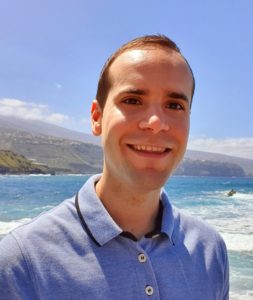T12 Title: The Future of UAV Cellular Communications
Organizer: Giovanni Geraci
Organizer: Adrian Garcia-Rodriguez
Abstract: Drones—a.k.a. UAVs—are taking over many processes requiring efficient, automated, and flexible machines. To guarantee that drones and their whole associated ecosystem take off, the top wireless communications companies and universities are trying to solve the fundamental challenge of providing reliable cellular service to this new class of mobile devices. While the understanding of drone cellular communications has advanced over the past few years, many fundamental challenges remain to be addressed. Indeed, the continuous flow of new drone-related applications demands original solutions to connect swarms of drones with high-capacity millimeter-wave capabilities, while handling their extreme mobility and guaranteeing hyper-reliable command and control links all along.
In this one-of-a-kind tutorial, we blend our academic and industrial views and take a holistic approach to UAV cellular communications:
• Outside the classroom: A fresh and digested look at the 3GPP standardization status and the performance of cellular-connected UAVs in 4G and 5G networks: lessons learnt and essential guidelines.
• Inside the classroom: Analyzing the fundamental tradeoffs in UAV mobility management for UAV-to-ground and direct UAV-to-UAV communications.
• 6G candidate architectures: Cell-free vs. multi-cell vs. mmWave UAV support, aerial channel modelling and deployment design through machine learning.
 Bio: Giovanni Geraci (SM’19) is an Assistant Professor at University Pompeu Fabra in Barcelona. He was previously a Research Scientist with Nokia Bell Labs and holds a Ph.D. from the UNSW Sydney. He also held research appointments at SUTD Singapore, UT Austin, CentraleSupelec, and Alcatel-Lucent.
Bio: Giovanni Geraci (SM’19) is an Assistant Professor at University Pompeu Fabra in Barcelona. He was previously a Research Scientist with Nokia Bell Labs and holds a Ph.D. from the UNSW Sydney. He also held research appointments at SUTD Singapore, UT Austin, CentraleSupelec, and Alcatel-Lucent.
He is an Editor for the IEEE Trans. on Wireless Commun. and IEEE Commun. Letters, a Guest Editor for the Special Issue on “UAV Communications for Safe Aerial Integration and Spectrum Coexistence” of the IEEE Open Journal of Veh. Tech., and the IEEE ICC’22 Wireless Commun. Symposium co-Chair. He has co-Chaired five workshops on UAV communications at IEEE ICC, IEEE PIMRC, and Asilomar.
He has delivered ten between Tutorials, Industry Seminars, and Workshop Keynotes at IEEE ICC, IEEE Globecom, IEEE WCNC, IEEE PIMRC, IEEE VTC, and ACM DroNet. He is co-inventor of a dozen patents and co-Editor of the book “UAV Communications for 5G and Beyond”, to be published by IEEE Wiley. On this topic, he has written for the IEEE ComSoc Tech. News and has received international press coverage.
He is a “la Caixa” Junior Leader and “Ramon y Cajal” Fellow. He received the Nokia Ireland Certificate of Outstanding Achievement in 2017, the 2018 IEEE ComSoc EMEA Outstanding Young Researcher Award, and the IEEE PIMRC’19 Best Paper Award for his work on UAV-to-UAV Cellular Communications.
 Bio: Adrian Garcia-Rodriguez is a Senior Research Engineer at Huawei Technologies R&D (France). He received the Ph.D. degree in Electrical and Electronic Engineering from University College London (U.K.), and he was a Research Scientist at Nokia Bell Labs (Ireland) in 2016-2020. Adrian is a co-inventor of 27 filed patent families and has co-authored 40+ IEEE publications on wireless communications and networking with 750+ citations.
Bio: Adrian Garcia-Rodriguez is a Senior Research Engineer at Huawei Technologies R&D (France). He received the Ph.D. degree in Electrical and Electronic Engineering from University College London (U.K.), and he was a Research Scientist at Nokia Bell Labs (Ireland) in 2016-2020. Adrian is a co-inventor of 27 filed patent families and has co-authored 40+ IEEE publications on wireless communications and networking with 750+ citations.
In top venues such as IEEE ICC or IEEE Globecom, he frequently delivers technical tutorials, organizes workshops and special sessions, and participates in industrial seminars focused the topics of UAV communications and next-generation 802.11 technologies. Adrian was a speaker of the industrial tutorial “Drone Base Stations: Opportunities and Challenges Towards a Truly ‘Wireless’ Wireless Network”, which won the Most Attended Industry Program award at IEEE Globecom’17.
He was the recipient of the Best Paper Award in PIMRC’19 for his work on “Cellular UAV-to-UAV Communications”. Adrian was also named an Exemplary Reviewer for IEEE Commun. Letters in 2016, and both IEEE Trans. on Wireless Commun. and IEEE Trans. on Commun. in 2017.
